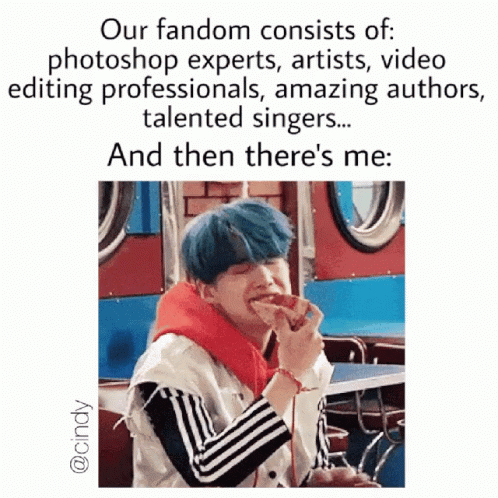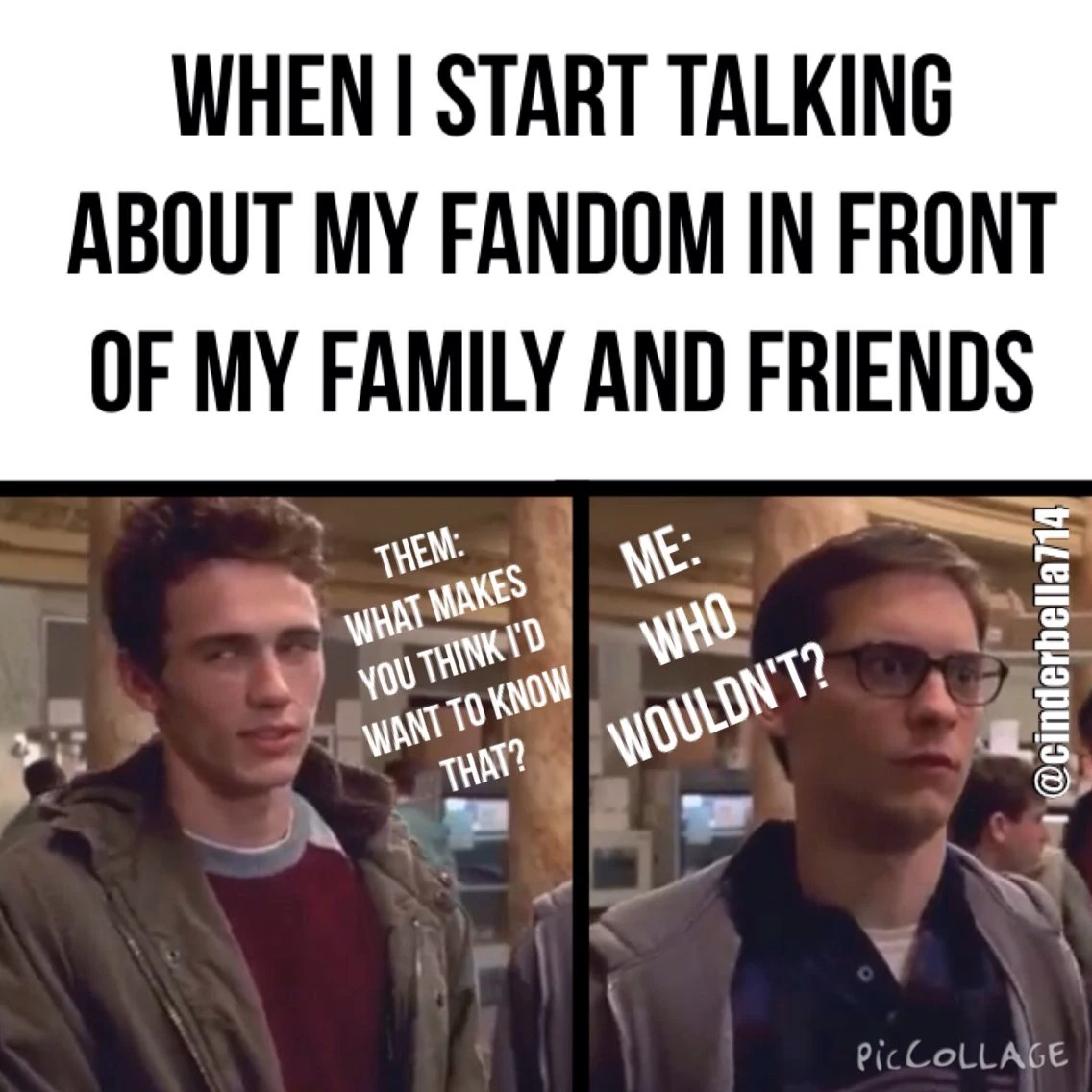3 Fandom as Participatory Culture
The last chapter ended with the suggestion that fans might constitute not only the most active of audiences, but also exemplary cases of participatory culture. This chapter explores how this might be the case. We have to first clarify what we mean by fans and how such an identity is distinguished from different types of audiences. Then, we have to clarify what fan-based participation in our contemporary networked media era looks like.
First, what do we mean when we aim to study fan-audiences? Perhaps the best way to understand fans is by contrasting them with other types of audiences. “Fans are more than simply consumers in view of their commitment to construct elaborate interpretations of their cult objects of consumption”[1] All audiences are consumers of something, but not all consumers are fans (even though, increasingly, it seems in vogue to say that people can be fans of anything). Fans, it must be said, don’t only orient themselves to cult objects but orient themselves in a cultish fashion. A “fan” is not merely an “aficionado” of something; a fan is much more of a “fanatic” in terms of their devotion. Not simply consuming or appreciating, a fan’s audience habits tend to be associated with “religious and political zealotry, false beliefs, orgiastic excess, possession and madness.”[2] One early example of this was frenzy was termed “Lisztomania”, remarking on audiences’ hysterical (as in hysteria or madness, not funny) response to performances by the composer Franz Liszt in the 1840s.[3]
Consequently, we can see how a fan is “a person with a relatively deep, positive emotional conviction about someone or something famous, usually expressed through recognition of style or creativity. He/ she is also a person driven to explore and participate in fannish practices.”[4] Therefore, though I might say I’m a fan of my dentist because he solves my dental problems, this isn’t what we mean by participatory fandom. I might be a fan, active in participatory culture through posting a google review for to share my thoughts and guide the potential future decisions of others, but I’m not taking up a social role through “fannish practices” like remixing videos or engaging in cosplay. To be a fan means “more than participation, which also covers prosumers, citizen journalism and so on. Being a fan is accompanied by interpersonal interactions and personal affective investments.”[5]
The notion that a fan is typically some form of “elite” audience member marks fans as active contributors to participatory culture, elevated above mere followers. “Followers are described as those who regularly consume and enjoy media texts/objects but claim no larger social identity on that basis.” Meanwhile, “being a fan is not merely about activity; it involves parallel processes of activity and identity.” It is widely assumed that fans go beyond using the media as directed and actively co-opt and create media content, often in an unruly or undisciplined fashion. Fans are “do-ers” versus “be-ers.”[6] Of course, followers participate in networked media culture too as they selectively consume media content and generate new understandings and new relationships within ongoing circuits of circulation and distribution. Thus, “participation [should] be understood as a continuum“[7] and fans can be located upon multiple continuums: from passive bystander to active agent; from irrational to rational; from individualistic to communal; from consumer to citizen; from resisting culture to affirming and transforming it. These tensions seem endemic to the study of fans.
Various traditions have dominated the study of fans at different points in (relatively recent) time. We might understand these as three waves of fandom.[8] The first wave largely studied fans as members of a subculture. Dominant discourse until the early 1990s defined fans as different from “people like us” and thus the first wave of scholarship examined fans as marginalized groups who were seeking a voice of their own, creatively responding to and resisting their pathologization by mainstream culture. This work has been typified by the phrase “fandom is beautiful,” charting the activity of fans who celebrate their otherness. The second wave largely saw fans as having moved beyond efforts to shape their own culture through subversive fan practices. Now, fans were engaging with mainstream culture rather than opposing it. Rather than arguing against their negative representation by creating their own distinct participatory culture, fans were becoming more active in more widespread and communal participatory cultures. The “crazy” fan — associated with fanatical practices — is replaced by the attractive fan, an audience whose passion is valued by media industries rather than scorned. Finally, the third wave of fan studies locates fans not just in the same cultural spaces as everyone else, but shifts attention to their cultural power. Digital fandom is much more normalized through its migration into the online environment, made more visible and accessible, and harnessing the power of networked media for its own purposes. Now no longer just the object of marketing, fans market their own agendas, becoming much more activist (not just active). Whereas the first wave’s focus was upon “creating alternative, even if temporary, sites where they can experience more caring and less dehumanizing forms of sociality,”[9] third wave studies of fandom often saw fans seeking a more caring and less dehumanizing society. While the first wave examined how fans were “textually productive”, the third wave studied how they were “socially productive.” Developing alongside communication technologies, we might understand the three main phases in the evolution of fandoms, following Jenkins, as (1) resistance, (2) participation, and (3) activism.[10]
Clearly, fandom is a contested term. Just because fans have more cultural capital now compared to decades ago does not mean they now form the dominant culture. We can complicate matters further by invoking the label “hegemonic fandom.” This suggests a negotiation of two contradictory discourses where fandom is viewed both positively since “everyone has to be a fan of something,” and negatively, since “everyone knows” that fans are obsessive.[11]
Traditionally, fandom has referred to the “specific social and cultural interactions, institutions and communities that have formed through the close interaction of committed groups of fans in a subcultural context.”[12] This tradition is hard to break as the subcultural stain of deviance has not been removed entirely. With hegemonic fandom, we can see the normalizing of fan identities, but not necessarily fan practices, often still mocked or not understood because of their excessiveness. The subcultural stain has faded, however, with the “fanification” of everything. Fanification represents the idea that “online fans essentially represent the way all audiences will interact with media from now on.”[13] Subcultures in a pre-internet era were often synonymous with fandom; they were fashioned out of a productive sense of community with fan practices and activities (like writing letters, forming zines, collecting, joining clubs, and attending conferences) fuelling group identities that were not tied to mainstream norms and habits. Fanification implies that, “armed with the tools of digital media, we will all eventually act like produser fans.”[14]

The introduction of the Internet (even before Web 2.0) made such activities much more accessible even as it made fandom more mediatized. Pre-electronic fandom didn’t generally contain lurkers. One wasn’t just a casual audience member. If you were part of a fandom, you were committed. The casualness of contemporary fandom suggests that not all users are fully ‘participatory fans’ and “in our embrace of the produser, we should not lose sight of the more mundane, internalized, even passive articulation with media that characterizes a great deal of media consumption.”[15]

Thus, even as the internet made it easier to be part of a fandom, it has changed the contours of it. Once upon a time, fandom was a marginalized group identity; fans were told to get a life, to which they often responded that fandom was a way of life.
Today, fans and their fandoms are seen as normal hobbies and attractive commodities for media industries; fandom, today, is a part of “real life.” However, some suggest that a dilution of fandom has accompanied its popularization. With its mainstreaming, there is arguably less of an emphasis upon community spirit. And just as there is no one type of fan, there is no one way of speaking of fandoms; We might do well to consider the concept of “ordinary” fandom: “the commonplace, everyday life media fandom that constitutes the largest group of affective media engagements without high levels of social connectivity arising out of fandom.”[16]

Evidently, “fandom today has broadened to consider as fannish any cultural expression by a group united by a particular interest that provokes an affective response.”[17] I recognize that fandom involves “the regular, emotionally involved consumption of a given popular narrative or text”[18] but I consider this to be a baseline – a starting point – rather than an endpoint of analysis. I don’t think that this means that the concept of fandom “loses the specificity that makes it meaningful and useful as an analytic.”[19] I think it means we have to presume affect, but not assume this extends beyond the individual. It may, of course, but for many fans, one’s fundamental affective connection may only extend to their relationship with a primary text rather than the relationship they have with fellow fans. And when one seeks to participate in “communities of shared values, opinions and feelings around particular topics or fields of experience,” we might use the term “‘ambient affiliation’ to describe [the] momentary bonds based on evolving topics of interest [wherein] users may not have known and interacted with each other and may not interact again.”[20] While we don’t see the waning of “affective connection,” the nature of that connection is changing.
Even though fandom is usually seen as a collective venture, “fans do not necessarily participate in fandoms for social ties and, in some cases, individually exploit fandoms as cultural resources.”[21] Thus, it is wise to admit that “fandom is a conflicted space and does not speak with a single voice; there are also diverse fan communities, not simply because of different tastes and interests, but also because of different norms, values, ideologies, and practices.”[22] Perhaps, given that, “social ties and community membership are not intrinsic to fandom … we should simply agree to conceive of fandom as a spectrum or constellation of experiences, activities, and communities—and leave it at that.” [23]
The point isn’t to finalize what fans or fandoms are, but rather to suggest what they do and what difference they make. “Even at a young age, most children have an idea about what fandom is [but] they appreciated how fandom can be applied to their daily lives.”[24] Fans participate in fandoms in order to participate in public life, in order to make sense of it, to play with it, and to assert their place within it. “Fandom has no progress, no end goal. Instead, it offers a way to “waste” endless hours in the company of like-minded people. People may become fans out of an enthusiasm for a fan object; but they stay participating fans … because of the play space that fandom and digital media offer them.”[25] This is meaningful behaviour, whether it is done as an individual who feels an emotional connection to a community or not. And indeed, the dichotomy between presumably communally-minded participatory fans and individualized non-participatory fans is arguably artificial. “The distinction between non‐participatory (passive, conformist) culture and participatory (active, transformative) culture often seems to make only limited sense. Many of the practices that fans constantly pursue—whether listening, screaming, dancing, record collecting, discussing music, or wearing t‐shirts—seem to integrate participation and consumption in ways that are routine and invited.”[26]
Even though Petersen claims that fandom is a seemingly pointless activity that promises no purpose of productivity,[27] all fans are nonetheless productive. Through their participation in networked media culture, fans-as-producers (rather than simplistic consumers) exhibit three types of clear productivity. We can understand fans as semiotically, enunciatively and textually productive.[28] Semiotic productivity “consists of the making of meanings of social identity and of social experience from the semiotic resources of the cultural commodity.” Popular culture doesn’t automatically make sense, especially to audiences with limited exposure to it or interest in it. When fans dedicate their attention to popular culture texts, they infer meaning from them, often in a way that less engaged audiences might not. At a very basic level, then, even consumption is productive – if we understand that people are producing meanings when they’re consuming. They’re active audience members (but barely). When fans communicate these meanings, we see enunciative productivity. Everyday discussion transforms our individual semiotic sense-making into a public resource. But any kind of meaning that is placed into social circulation counts — wearing team colours or sporting a particular brand also marks one’s affiliation and audience identity. The third level of production is textual productivity. We see this when fans produce “texts” for circulation within the fan community itself. At this level, one’s products become a resource for other fans. When we get into fans as prosumers or produsers, we’re exploring levels of textual productivity. Even making a comment in a fan forum satisfies this, literally creating text around something, whether or not it is simply to share interpretations or to forge social connections. Writing fan-fiction or protest letters is another level of textual engagement. But it is important to note that fans don’t only produce literal text – “texts” is used in a cultural studies sense to denote anything that is made, from which we can then make meaning. Whenever we produce an interpretation of something’s meaning (a book, television episode, TikTok video, Instagram reel, a t-shirt or a monument, etc), we treat it as a text. When these interpretations are in our own heads, they’re semiotic productions. When these interpretations are produced for others, they’re enunciative, but when our interpretations are fashioned into other cultural products (or “works of art”), they become textually productive. Because works are by-products of merely the original creator – the artist. Texts, on the other hand, are not meaningful simply because of the way that the original creator “wrote” the text, but also because audiences “read” (and through the act of consumption, re-write) texts. It can even be said that texts don’t exist until they are engaged with by audiences. So, creating costumes or fan art, etc. also involves “writing texts” (for others to read …). Textual productivity entails material production insofar as you’re creating material for other people to see and to help construct a sense of (shared) identity.

No matter what “wave” of fandom one might be in, no matter what you might be a fan of, the basic feeling that motivates audiences is the same: affective sensibility. This is the domain of one’s mood, suggesting that people tune into things (and other people who are similarly attuned) based on how they feel, how animated they are about those things. One’s participation in a cultural scene is saturated with affect. Whereas a consumer engages with certain things because, in some fashion, they are entertaining and provide them with enjoyment and pleasure, the fan is motivated by affect, energized and invigorated by their engagement.
Fandom, much like religion, involves an intensely affective experience. We don’t experience the things we love—films, television shows, books, music—as just a text, but as a site of intense emotional engagement. They alternately bring us great joy and enrage us. They comfort us or they push us toward social change. They provide us with community but also offer us food for individual contemplation.[29]
Some “non-participatory fans” might only want to immerse themselves in a text, but others can take that energy and translate it into something else.The affective sensibility does not automatically attach us to other fans; it describes, rather, the process whereby fans “actively constitute places and forms of authority (both for themselves and for others) through the mobilization and organization of affective investments.”[30] Thus, anything can act as a meaningful “place,” especially ‘sacred’ sites associated with celebrities or favourite films or TV series. When fans take pilgrimages to these sites, they can be places of communal celebration, but are often places for quiet reflection and solitary communing.[31]

But the TV series or celebrity or brand can also serve as a symbolic “place” in which we invest ourselves. For instance, we communicate our affiliation and construct our identity “when we use a movie quote to make a point or wear a T-shirt of a specific TV character as a representation of who we are and what we care about.”[32]

The affective sensibility allows us to discriminate between the things that matter to us. After all, one cannot exist in a world where nothing matters. The affective sensibility highlights what things matter most to us, and declares to the world what we invest in as a source of meaning, fashioning our identity not merely in a celebratory fashion, but as a form of empowerment. Empowerment, here, refers to the generation of energy and passion that can open up possibilities for new meanings and more engagement with others. Consumers simply invest in something that affects them; Fans invest in something in order to invest in themselves, to build up their sense of self (and their relationships with others). If you are a fan of something, it matters to you. For some, it matters enough to share with others, the affective sensibility laying the groundwork for an affective connection with others. For the most participatory of fans, it is meaningful as a form of community engagement. For all fans, it is the source of their “affective labour,” a concept we will explore in greater depth in the next chapter.
- Fuschillo, Gregorio (2020) “Fans, fandoms, or fanaticism?” Journal of Consumer Culture, Vol. 20(3), p. 348. ↵
- Jenkins, H. (1992) Textual Poachers: Television Fans and Participatory Culture. New York: Routledge, p. 12. ↵
- The lyrics of the chorus include the words: "Think less but see it grow, Like a riot, like a riot, oh, Not easily offended, Know how to let it go, From a mess to the masses" (kind of poetically referencing the mad nature of excessive audience investment (affective connection with other fans and with the idol-like performer). More than a century later, "Beatlemania" described a similar response to the then newcomers on the musical scene (though it was seen as crazed, it wasn't deemed to be the same degree of pathology). Interestlingly, the band singing Lisztomania (Phoenix) was a featured performer in the closing ceremonies of the 2024 Paris olympics (when athletes rushed the stage in "unceremonious" fashion... ↵
- Duffett, M. (2013) Understanding Fandom: An Introduction to the Study of Media Fan Culture. London: Bloomsbury Publishing, p. 18. ↵
- Petersen, Line Nybro (2022) Mediatized Fan Play Moods, Modes and Dark Play in Networked Communities. New York, NY: Routledge, p. 27. ↵
- C. Lee Harrington and Denise Bielby (2018) "Soap Fans, Revisited." in A Companion to Media Fandom and Fan Studies, T. Booth (ed.), pp. 84-5. ↵
- Bury, Rhiannon (2018) "'We're not there': Fans, Fan Studies, and the Participatory Continuum" in The Routledge Companion to Media Fandom, Edited by Melissa A. Click and Suzanne Scott. p. 125. ↵
- Jonathan Gray, Cornel Sandvoss, and C. Lee Harrington (2007) Fandom: Identities and Communities in a Mediated World, 2nd ed. (New York: New York University Press. ↵
- Fuschillo, p. 354. ↵
- Fuschillo, p. 352. ↵
- Hills, M. (2005), ‘Negative fan stereotypes (“get a life!”) and positive fan injunctions (“everyone’s got to be a fan of something!”): Returning to hegemony theory in fan studies’, Spectator, 25:1, p. 40. ↵
- Sandvoss, C. (2005) Fans:The Mirror of Consumption, Cambridge UK: Polity Press, p. 5. ↵
- Bird, S. Elizabeth (2011) “Seeking the Audience for News: Response, News Talk, and Everyday Practices.” In The Handbook of Media Audiences (Virginia Nightingale, ed.). Malden, MA: Blackwell, p. 503 ↵
- Bird, p. 504 ↵
- Bird, p. 504 ↵
- Sandvoss, Cornel, and Laura Kearns. 2014. “From Interpretive Communities to Interpretive Fairs: Ordinary Fandom, Textual Selection and Digital Media.” In The Ashgate Research Companion to Fan Cultures, edited by Linda Duits, Koos Zwaan, and Stijn Reijnders, Farnham: Ashgate, pp. 92-3. ↵
- Hellekson, Karen (2018) “The Fan Experience” in A Companion to Media Fandom and Fan Studies (P. Booth, ed.) Hoboken, NJ: John Wiley & Sons Inc., p. 66. ↵
- Sandvoss, p. 8. ↵
- Bury, Rhiannon (2018) "'We're not there': Fans, Fan Studies, and the Participatory Continuum" in The Routledge Companion to Media Fandom, Edited by Melissa A. Click and Suzanne Scott. p. 124. ↵
- Fryer, Daniel Lees (2022) “#AllCatsAreBeautiful: Ambient affiliation and the visual-verbal representation and appreciation of cats in online subversive discourses.” Discourse & Society 2022, Vol. 33(1) 3–33, p. 4. ↵
- Fuschillo, Gregorio (2020) “Fans, fandoms, or fanaticism?” Journal of Consumer Culture, Vol. 20(3), p. 358. ↵
- Jenkins, Henry (2018) "Fandom, Negotiation, and Participatory Culture." in A Companion to Media Fandom and Fan Studies (T. Booth, ed.). p. 21. ↵
- C. Lee Harrington and Denise Bielby (2018) "Soap Fans, Revisited." in A Companion to Media Fandom and Fan Studies, T. Booth (ed.), p. 85. ↵
- Booth, Paul, and Helena Louise Dare-Edwards (2021) "‘No one’s a fan of anything anymore, like, this isn’t 2002’: Surveying 7–17-year- olds on being a fan and contemplating the future of fandom." Journal of Fandom Studies, 9(3), p. 214. ↵
- Petersen, Line Nybro (2022) Mediatized Fan Play Moods, Modes and Dark Play in Networked Communities. New York, NY: Routledge, p. 15. ↵
- Duffett, Mark (2018) “Insights from Two Decades as a Music Fan Researcher.” in A Companion to Media Fandom and Fan Studies (P. Booth, ed.) Hoboken, NJ: John Wiley & Sons Inc., p. 465. ↵
- Petersen, Mediatized Fan Play Moods, p. 15 ↵
- Fiske, J. (1992) ‘The Cultural Economy of Fandom’, in L.Lewis (ed.), The Adoring Audience: Fan Culture and Popular Media, London: Routledge. ↵
- Zubernis, Lynn, and Katherine Larsen (2018) “Make Space for Us!Fandom in the Real World.” In A Companion to Media Fandom and Fan Studies (P. Booth, ed.) Hoboken, NJ: John Wiley & Sons Inc., p. 151 ↵
- Grossberg, Lawrence (1992). “Is there a fan in the house? The affective sensibility of fandom.” In L. A. Lewis (Ed.), The adoring audience: Fan culture and popular media. New York, NY: Routledge, p. 59. ↵
- Zubernis and Larsen, p. 152. ↵
- Dill-Shackleford (2020). Finding Truth in Fiction: What Fan Culture Gets Right--and Why it's Good to Get Lost in a Story. Oxford: Oxford University Press, p. 170 ↵


